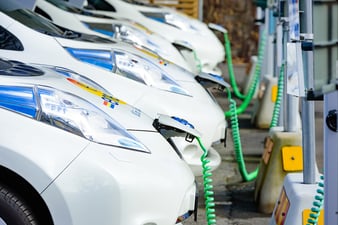 Electric vehicles (EVs) have been around since the early 1900’s and today there are over 340,000 electric vehicles in the US alone, the largest fleet anywhere in the world. With the price of recharging an electric vehicle being almost half the equivalent of a tank of gasoline, it’s no wonder these vehicles are gaining popularity. There are a few different types of electric vehicles currently available to consumers; they are battery electric vehicles (BEV), hybrid vehicles, plug-in hybrid electric vehicles (PHEV), and fuel cell electric vehicles (FCEV).
Electric vehicles (EVs) have been around since the early 1900’s and today there are over 340,000 electric vehicles in the US alone, the largest fleet anywhere in the world. With the price of recharging an electric vehicle being almost half the equivalent of a tank of gasoline, it’s no wonder these vehicles are gaining popularity. There are a few different types of electric vehicles currently available to consumers; they are battery electric vehicles (BEV), hybrid vehicles, plug-in hybrid electric vehicles (PHEV), and fuel cell electric vehicles (FCEV).
Fully electric vehicles have some large upside when it comes to safety. Although they can reduce or eliminate some hazards seen in gasoline or diesel vehicles, this does not mean that electric vehicles don’t present hazards of their own. A main advantage of EVs is they do not use a highly flammable and explosive liquid such as gasoline or diesel fuel to operate. When operators fuel a gasoline or diesel vehicle they are exposed to possible fire hazards from static electricity igniting the fuel, as well as toxic fumes that are emitted from gasoline. Electric recharging stations have no exposure to toxic fumes because electricity doesn’t give off any hazardous vapors. There are also many safety measures in place that prevent anyone from being injured during charging.
First, the charging cable is not live while being handled. A proper connection to the vehicle must be made and verified before charging will begin. Once the charging cable is connected, the system software automatically performs a health check to determine the battery’s voltage, capacity, and state of charge. Only after everything has checked out okay will the computer initiate charging and allow current to flow through the cable. Second, EV charging systems employ multiple automatic failsafe protection systems to immediately cut power if any irregularity is detected during charging. For example, if the charging cable comes loose or is removed from the vehicle, power is shut off before any cable or connector terminals are exposed. If a voltage leak is detected, a ground fault circuit interrupt (GFCI) system halts charging to prevent the possibility of a user being shocked. Lastly, every charging system incorporates surge sensing capabilities that will cut power to protect the vehicle battery and electronics in the event of power grid problems. In all, operators are far safer recharging an electric vehicle compared to refueling a gas or diesel vehicle.
Electric cars typically have higher crash test ratings compared with conventional vehicles. This is due to a few different variables. First, there is no engine in the front of the vehicle, meaning in the event of a head on frontal crash the engine is not pushed back into the driver causing injury. With the electric motor in back and a trunk in the front, EVs have larger, frontal crash-protection crumple zones that are designed to absorb the energy from the impact during a traffic collision by controlled deformation. In addition, battery packs are stored under the floor of electric vehicles, giving a better overall weight distribution and a lower center of gravity. This allows electric vehicles to handle much better when driving and makes it much harder for them to roll over compared to gasoline or diesel vehicles.
Electric vehicles can pose a significant electrocution hazard compared to conventional vehicles. A standard car battery carries 12 volts; the battery inside an EV can surge up to 600 volts. Thus, presenting a much greater hazard to maintenance workers, owners, and first responders that are exposed to the battery. Manufacturers are still required to meet Federal Motor Vehicle Safety Standards and undergo the same rigorous safety testing as conventional vehicles sold in the United States. Every effort is taken to prevent hazardous incidents from occurring inside these vehicles. Their battery packs are encased in sealed shells and meet testing standards that subject batteries to conditions such as overcharge, vibration, extreme temperatures, short circuit, humidity, fire, collision, and water immersion. Manufacturers design the vehicles with insulated high-voltage lines and safety features that deactivate the electrical system when they detect a collision or short circuit. Despite all these safety measures, special training is still needed to be able to properly maintain an electric vehicle to insure its energy source is properly locked out before being worked on. NFPA provides online and in person training for maintenance workers and first responders on how to deal with electrical vehicles in an emergency situation. They show how to properly shut down and isolate the power supply of a vehicle after a crash so the first responders can safely work on these vehicles.
Electric vehicles offer many benefits to owners today. Completely emissions free driving is not only nonpolluting and better for the environment, but also nonhazardous to any operators. The simple design means there are less moving parts, making these vehicles extremely easy to maintain and less likely that they will break down. Some estimate the price to regularly maintain an electric vehicle is 1/3 that of a gasoline or diesel powered vehicles. The better overall weight distribution improves the vehicles center of gravity making it a better handling and safer vehicle to drive. However, batteries can carry up to 600 volts; owners, maintenance workers, and first responders should be properly trained and know all the hazards when performing any work on electrical vehicles. Overall, because these vehicles do not operate on flammable and explosive liquids they are some of the safest vehicles to own and operate today.





